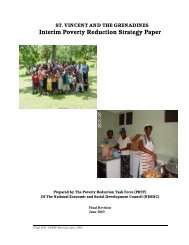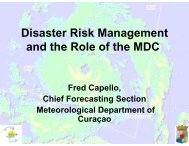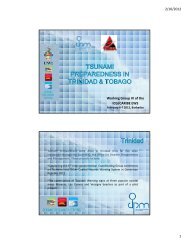The Anatomy of A Silent Crisis The Anatomy of A Silent Crisis
The Anatomy of A Silent Crisis The Anatomy of A Silent Crisis
The Anatomy of A Silent Crisis The Anatomy of A Silent Crisis
- TAGS
- anatomy
- www.bb.undp.org
Create successful ePaper yourself
Turn your PDF publications into a flip-book with our unique Google optimized e-Paper software.
End notes<br />
101<br />
University Press, Cambridge, UK, 273-313, p 299.<br />
and Parry, M., Rosenzweig, C., and Livermore, M.<br />
(2005): “Climate Change, Global Food Supply and Risk<br />
<strong>of</strong> Hunger.” Philosophical Transactions <strong>of</strong> the Royal<br />
Society, 360, 2125-2138, p.2136.<br />
76. Parry, M., Rosenzweig, C., and Livermore, M. (2005):<br />
“Climate Change, Global Food Supply and Risk <strong>of</strong><br />
Hunger.” Philosophical Transactions <strong>of</strong> the Royal<br />
Society, 360, 2125-2138, p.2136.<br />
77. <strong>The</strong> estimates for production losses and price increase<br />
are based on crop model projections which focus on<br />
changes in yield. Other models exist, such as agroeconomic<br />
models, i.e. Fischer et al. (2005), which come<br />
up with somewhat more conservative estimates, (this<br />
model includes assumptions related to mitigating actions<br />
by economic actors like shifting crop production between<br />
regions). Please see Fischer (2005) and Easterling, W.E.,<br />
et al. (2007) from the IPCC for more information.<br />
78. Boko, M., et al. (2007): “Africa.” Climate Change 2007:<br />
Impacts, Adaptations and Vulnerability, Contribution<br />
<strong>of</strong> Working Group II to the Fourth Assessment Report<br />
<strong>of</strong> the Intergovernmental Panel on Climate Change,<br />
M.L. Parry, et al. Eds., Cambridge University Press,<br />
Cambridge, UK, 433-467, p.435.<br />
79. Relief Web. (2009): “Uganda: Rising temperatures<br />
threatening livelihoods.” ReliefWeb¸March 3.<br />
http://www.reliefweb.int/rw/rwb.nsf/db900SID/JBRN-<br />
7PSK45?OpenDocument.<br />
80. Rugumayo, A.I. and Mwebaze, D.B., (2002):<br />
“Drought-Intensity Duration and Frequency Analysis:<br />
A Case Study <strong>of</strong> Western Uganda.” Journal <strong>of</strong> the<br />
Chartered Institution <strong>of</strong> Water and Environmental<br />
Management, ISSN 1360-4015, Issue 16, Number 2<br />
p.111-115.<br />
81. Makunike, C. (2008) “Climate change threatens<br />
food security in Uganda’s Karamoja region.” Africa<br />
News Network, African Agriculture, April 6. http://<br />
africanagriculture.blogspot.com/2008/04/climatechanges-threaten-food-security.html.<br />
82. All Africa. (2009): “Uganda: Rising Temperatures<br />
Threatening Livelihoods.” All Africa and IRIN, March 3.<br />
http://www.wfp.org/news/hunger-in-the-news?tid=332.<br />
83. WWAP. (2005): “National water development report:<br />
Uganda.” World Water Assessment Programme and<br />
Directorate <strong>of</strong> Water Development, Prepared for 2nd<br />
UN World Water Development Report, p.116-118.<br />
http://www.unesco.org/water/wwap/wwdr/wwdr2/<br />
case_studies/uganda/index.shtml.<br />
84. According to World Food Programme, economists<br />
estimate that each child whose physical and mental<br />
development is stunted by hunger and malnutrition<br />
stands to lose 5-10 percent in lifetime earnings. WFP.<br />
(2009): “World Hunger.” World Food Programme.<br />
http://www.wfp.org/hunger.<br />
85. IMC. (2009): “Climate Change and Higher Food Costs<br />
Spark Widespread Hunger in Indonesia.” International<br />
Medical Corps. http://www.imcworldwide.org/content/<br />
article/detail/2029.<br />
86. Naylor, R., et al. (2007): “Assessing risks <strong>of</strong> climate<br />
variability and climate change for Indonesian rice and<br />
agriculture.” Proceedings <strong>of</strong> the National Academy <strong>of</strong><br />
Sciences, Volume 104, Number 19, May 8.<br />
87. Kalaugher, L. (2007): “Climate models indicate rice<br />
agriculture in Indonesia will suffer.” Environmental<br />
Research Web. May 9. http://environmentalresearchweb.<br />
org/cws/article/research/29931.<br />
88. Peace. (2007): “Indonesia and climate change:<br />
current status and policies.” World Bank, p.4. http://<br />
siteresources.worldbank.org/INTINDONESIA/<br />
Resources/Environment/ClimateChange_Full_EN.pdf.<br />
89. FSE results reveal an increase in the probability <strong>of</strong> a<br />
30 day delayed monsoon as a result <strong>of</strong> changes in<br />
average climate from 9-18% today to 30-40% in 2050.<br />
Naylor, R., et al. (2007): “Assessing risks <strong>of</strong> climate<br />
variability and climate change for Indonesian rice and<br />
agriculture.” Proceedings <strong>of</strong> the National Academy <strong>of</strong><br />
Sciences, Volume 104, Number 19, May 8.<br />
90. Ghebreyesus et al. (2008): “Public health and<br />
weather services-climate information for the health<br />
sector.” WMO Bulletin, 57(4), October.<br />
91. Epstein, P.R (2006): Climate Change Futures:<br />
Health, Ecological and Economic Dimensions. <strong>The</strong><br />
Center for Health and the Global Environment, Harvard<br />
Medical School.







